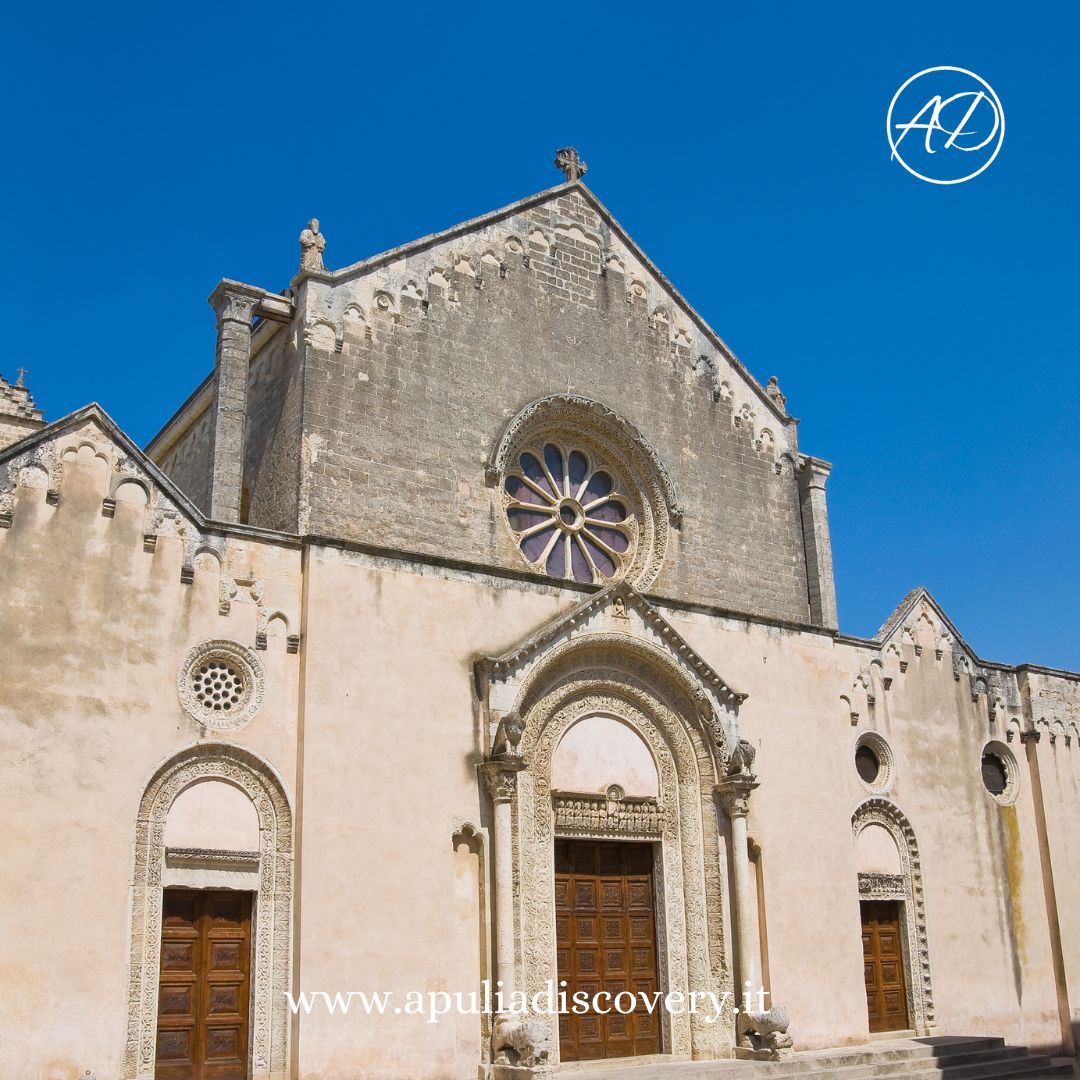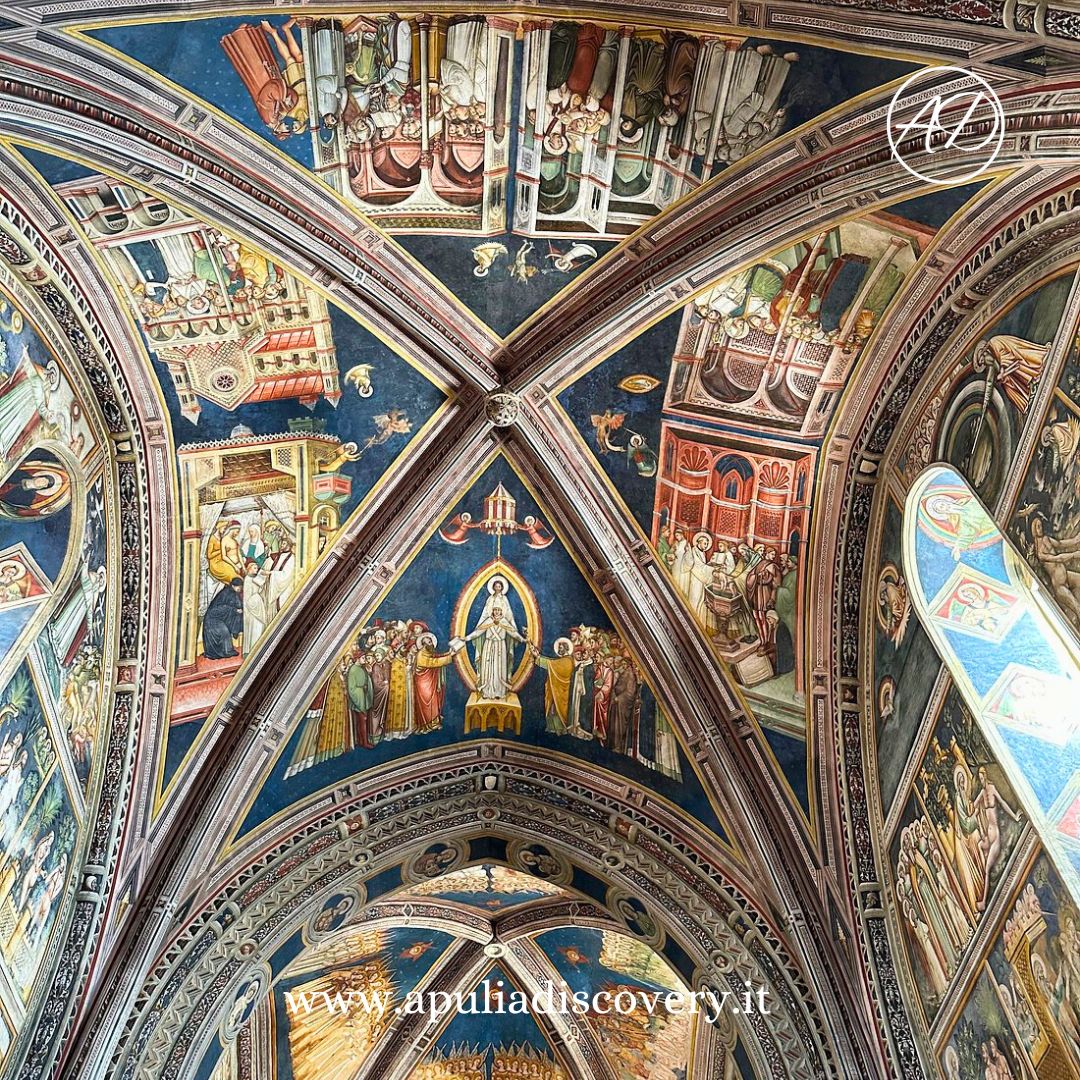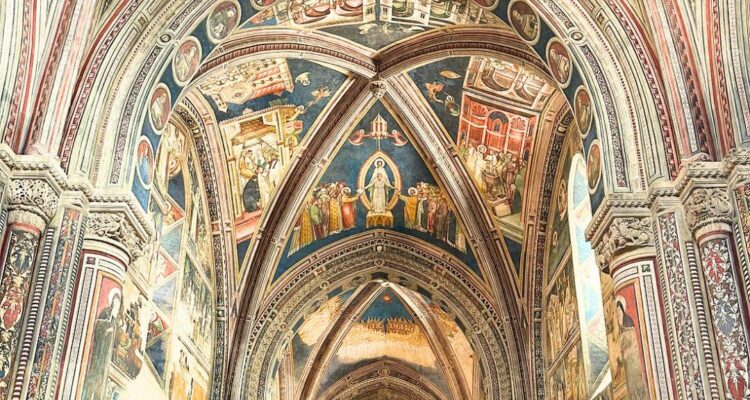History and Foundation of the Basilica of Saint Catherine of Alexandria
The Early Years and Origins of the Basilica of Saint Catherine of Alexandria
In the vibrant heart of Galatina, Puglia, stands a building that has left a significant mark on the region’s history and art: the Basilica of Saint Catherine of Alexandria. According to tradition, this magnificent Gothic structure was commissioned by Raimondo Orsini del Balzo between 1369 and 1391. However, recent discoveries and studies have led experts to reconsider this timeline, suggesting that the basilica may have evolved from a preexisting structure.
Architectural and artistic elements predating the 14th century support this theory. A notable example is the fresco “Madonna della Mela,” attributed to Lucia d’Altavilla, which predates the construction attributed to Raimondo Orsini del Balzo. This fresco not only highlights the basilica’s complex historical layering but also represents one of the earliest and most significant examples of sacred art in the building, a masterpiece that continues to captivate visitors with its ethereal beauty and deep spirituality.
Raimondello Orsini del Balzo and the Crusades
 Raimondello Orsini del Balzo, Count of Soleto since 1319, is a key figure in the history of the Basilica of Saint Catherine of Alexandria. His adventurous life, steeped in religious fervor, is closely tied to the building’s story. After a pilgrimage to Mount Sinai during one of his crusade-related journeys, Raimondello returned to Galatina with an invaluable relic: the finger of Saint Catherine of Alexandria. This sacred object, still carefully preserved in the church’s treasury, not only symbolizes religious devotion but also represents the tangible link between the basilica and the history of the Crusades, crucial moments that shaped the Christian identity of medieval Europe.
Raimondello Orsini del Balzo, Count of Soleto since 1319, is a key figure in the history of the Basilica of Saint Catherine of Alexandria. His adventurous life, steeped in religious fervor, is closely tied to the building’s story. After a pilgrimage to Mount Sinai during one of his crusade-related journeys, Raimondello returned to Galatina with an invaluable relic: the finger of Saint Catherine of Alexandria. This sacred object, still carefully preserved in the church’s treasury, not only symbolizes religious devotion but also represents the tangible link between the basilica and the history of the Crusades, crucial moments that shaped the Christian identity of medieval Europe.
After Raimondello’s death in 1405, responsibility for the basilica passed to his family. His wife, Maria d’Enghien, took up his project, completing the building and enriching it with new artworks. Following her husband’s wishes, Maria d’Enghien passionately dedicated herself to completing the basilica, transforming it into a symbol of faith and beauty. Their son, Giovanni Antonio Orsini del Balzo, also made significant contributions, continuing his father’s work and giving the building the mix of majesty and spirituality that still characterizes it today.
Raimondello and his family’s efforts went beyond the physical construction of the building; they enriched the basilica with invaluable works of art, turning it into a treasure trove of artistic and spiritual treasures. This legacy, passed down through generations, has ensured that the Basilica of Saint Catherine of Alexandria became not only a place of worship but also a symbol of Gothic culture and art in Puglia, a monument that tells stories of faith, art, and history.
The Basilica of Saint Catherine of Alexandria, with its intricate and fascinating history, is much more than just a religious building. It is a living symbol of how faith, art, and history can intertwine to create something truly extraordinary. Every stone, fresco, and sculpture within its walls tells a part of this story, a story that continues to live and captivate every visitor who crosses the threshold of this incredible monument.
The Early Years and Origins of the Basilica of Saint Catherine of Alexandria
The Basilica of Saint Catherine of Alexandria, located in the historic heart of Galatina, is a true gem of Gothic architecture in Puglia. Its construction, traditionally attributed to Raimondo Orsini del Balzo between 1369 and 1391, occurred during a period of significant historical and artistic activity. However, more recent studies suggest that the basilica may represent the evolution of a preexisting structure, as evidenced by the presence of artistic and architectural elements predating the 14th century.
Architecture and Unique Features
The Romanesque-Gothic Façade
 The façade of the Basilica of Saint Catherine of Alexandria is an extraordinary example of the fusion between Apulian Romanesque and Gothic elements. Characterized by a tricuspidal form, the façade reveals the skill of the artisans of the time in working with Lecce stone, giving the building a unique and unmistakable appearance. The rose window, the central element of the façade, is a masterpiece of fine carving, resembling lace made of stone that magically captures and filters light, creating an almost surreal atmosphere inside the church.
The façade of the Basilica of Saint Catherine of Alexandria is an extraordinary example of the fusion between Apulian Romanesque and Gothic elements. Characterized by a tricuspidal form, the façade reveals the skill of the artisans of the time in working with Lecce stone, giving the building a unique and unmistakable appearance. The rose window, the central element of the façade, is a masterpiece of fine carving, resembling lace made of stone that magically captures and filters light, creating an almost surreal atmosphere inside the church.
The distinctive features of this façade extend beyond the rose window. The three portals, finely crafted, boast a wealth of geometric and vegetal motifs that intertwine to create a visually striking effect. The octagonal edicule, added in 1460, clearly represents the Gothic style, demonstrating the architects’ ability to incorporate new stylistic elements into a preexisting context, creating a harmonious dialogue between different eras and styles.
The Interior: A Blend of Styles and Influences
Upon entering the basilica, visitors are immediately enveloped in an atmosphere of solemn majesty. The interior, with five naves, is a veritable sacred theater where architecture, art, and faith come together to create a unique experience. The division into naves is emphasized by robust columns and pointed arches, which guide the eye toward the altar and the octagonal tribune built by Raimondello’s son, Giovanni Antonio.
The interior pictorial decoration is of fundamental importance in the basilica. The nine pictorial cycles adorning the walls and vaults offer a journey through various religious and artistic themes. From scenes of the Apocalypse to the stories of Genesis, each cycle tells not only biblical stories but also the history of Apulian art of the time, revealing influences from different schools and styles, from Byzantine traditions to Gothic and Romanesque currents.
The skill of the artists who worked on these frescoes is evident in every detail. The painting technique, which uses vivid colors and strong contrasts, along with their mastery in depicting human figures and narrative scenes, makes these frescoes true masterpieces capable of vividly and compellingly narrating sacred stories.
In conclusion, the Basilica of Saint Catherine of Alexandria is not just a place of worship, but a compendium of history, art, and faith that continues to amaze and inspire generations of faithful, scholars, and visitors. Every element, from the majestic Romanesque-Gothic façade to the interiors decorated with extraordinary mastery, speaks of a rich and complex past and a community that has blended faith, art, and culture in a monument that remains a beacon of spirituality and beauty in the heart of Puglia.
The Frescoes: An Artistic Treasure
 The Basilica of Saint Catherine of Alexandria is a veritable treasure trove of artistic gems, and among these, the frescoes are one of its most precious elements. Painted primarily in the 14th century, these mural masterpieces are the result of a harmonious blend of Giotto and Sienese artistic influences, two pivotal currents in medieval Italian art.
The Basilica of Saint Catherine of Alexandria is a veritable treasure trove of artistic gems, and among these, the frescoes are one of its most precious elements. Painted primarily in the 14th century, these mural masterpieces are the result of a harmonious blend of Giotto and Sienese artistic influences, two pivotal currents in medieval Italian art.
Giotto and Sienese Influences
Giotto, with his revolutionary conception of space and the human figure, left an indelible mark on 14th-century art, a legacy clearly visible in the basilica’s frescoes. These works exhibit a deep understanding of the human form, volume, and emotion, breaking away from the static and idealized nature typical of earlier Byzantine art.
Similarly, the influence of the Sienese school, with its refinement, vivid colors, and elegant lines, adds another layer of beauty and complexity to the frescoes. Artists such as Simone Martini and the Lorenzetti brothers contributed to developing a style that emphasizes grace and expressiveness, features evident in the basilica’s frescoes.
The Pictorial Cycle of the Seven Sacraments
The most famous pictorial cycle in the Basilica of Saint Catherine is that of the Seven Sacraments, located in the sails of the second bay. This cycle is an exceptional example of the integration of Giotto and Sienese techniques. The scenes depict the sacraments of the Catholic Church – Baptism, Eucharist, Confirmation, Confession, Marriage, Ordination, and Anointing of the Sick – each narrated with emotional depth and rich detail that captivate the viewer.
In these frescoes, the characters are portrayed with a naturalness and expressiveness that bring the sacred scenes to life. Every gesture and glance tells a story, conveying not only the religious message but also a profound sense of humanity. The depiction of the Seven Sacraments goes beyond mere religious instruction: it is a celebration of life, its fundamental stages, and the central role of faith in each one.
The Importance of the Pictorial Cycles
The Basilica of Saint Catherine of Alexandria, due to the breadth and quality of its pictorial cycles, is considered second only to the Basilica of Saint Francis of Assisi. Each fresco is a chapter in a great open book on the history of art, faith, and culture of the Italian Middle Ages.
These frescoes are not only works of inestimable artistic value; they are also precious testimonies of an era, visual documents that reveal the beliefs, values, aspirations, and knowledge of a distant time. They provide a glimpse into the mentality and spirituality of the people who lived centuries ago, offering an intimate and profound view of their lives and their world.
Furthermore, the variety of themes addressed – from daily life to biblical scenes, allegories, and portraits of saints – makes these frescoes a comprehensive overview of medieval culture. They represent a bridge between past and present, between the sacred and the secular, demonstrating how art can simultaneously be an expression of faith and a mirror of everyday life.
In conclusion, the frescoes of the Basilica of Saint Catherine of Alexandria are much more than mere decorations. They are pages of history, works of extraordinary beauty, expressions of faith, and testimonies of an era. Visiting the basilica and admiring these frescoes is like embarking on a journey through time to discover a distant world that remains alive in the images and colors adorning its walls.
The Octagonal Tribune and Its Significance
The Basilica of Saint Catherine of Alexandria contains a structure within that stands out for its uniqueness and importance: the octagonal tribune. This architectural element, constructed in the mid-15th century, is not only an excellent example of the period’s architecture but also embodies profound spiritual and familial significance.
Architectural Aspects
The octagonal tribune is distinguished by its refined and innovative architectural structure, particularly rare in Puglia at that time. This octagonal shape was an uncommon choice in religious architecture of the era, making the tribune a significant example of stylistic evolution and architectural experimentation in the 15th century.
The tribune rises at the end of the choir, creating a visual and spiritual focal point within the basilica. Each side of the octagon is enriched with decorative elements that reflect the artistic taste of the time, harmoniously combining Gothic style with emerging Renaissance influences. The dome above the tribune creates a sense of elevation and lightness, guiding the faithful’s gaze and spirit upward in a movement that symbolizes the ascent toward the divine.
The Mausoleum of Giovanni Antonio Del Balzo Orsini
At the center of the octagonal tribune is the mausoleum of Giovanni Antonio Del Balzo Orsini, a feature of immense historical and artistic importance. This mausoleum is not just a resting place for a significant member of the Orsini del Balzo family but also a work of art that reflects the period’s rich cultural and artistic heritage.
The mausoleum, an exquisite example of family funerary architecture, demonstrates the skill of the 15th-century artisans and artists in working stone and creating compositions that blend beauty, religious symbolism, and dynastic pride. The sculptural elements and decorations that adorn the mausoleum narrate not only Giovanni Antonio’s personal story but also that of his family and their era, making the mausoleum a tangible testimony to the historical and cultural events of the time.
The mausoleum’s presence within the tribune adds another layer of meaning to the entire structure. It represents the link between the earthly and the spiritual, between mortal life and eternity. The mausoleum’s position, at the center of the tribune and therefore the basilica, symbolizes the centrality of death and memory in Christian life, reminding the faithful of the transience of earthly life and the importance of one’s actions.
Moreover, the tribune and mausoleum together create a place for reflection and prayer where visitors can connect with history and spirituality on a profoundly personal level. The artistic beauty and historical importance of the octagonal tribune and the mausoleum of Giovanni Antonio Del Balzo Orsini make the Basilica of Saint Catherine of Alexandria not just a place of worship but also an important cultural site, bearing witness to the traditions, beliefs, and art of a critical era in Italian history.
In conclusion, the octagonal tribune and the mausoleum of Giovanni Antonio Del Balzo Orsini represent a harmonious blend of art, architecture, history, and spirituality. These elements, so closely intertwined within the basilica, offer visitors a unique experience where artistic beauty merges with the depth of faith and richness of history, creating a place where past and present converse in a universal language of beauty and meaning.
The Caterinian Convent and Its History
The Caterinian Convent, adjacent to the Basilica of Saint Catherine of Alexandria, is a historic monument of inestimable value that narrates centuries of religious and cultural history in Galatina. Initially founded in the 15th century, the convent underwent a transformation and reconstruction process between the 16th and 17th centuries, reflecting the architectural and artistic changes of those eras.
From the 15th-Century Monastery to the Current Structure
The original convent, built in the 15th century, was a simple yet imposing monastic structure conceived to meet the needs of the Franciscan community that lived there. Over the centuries, the convent underwent significant modifications, reflecting the architectural and artistic developments of the time. The reconstruction that took place between the 16th and 17th centuries transformed the convent into a larger, more ornate structure, enriched with new artistic and architectural elements that increased its historical and cultural value.
The Cloister and the Frescoes of 1696
The heart of the convent is its quadrangular cloister, frescoed in 1696 by Brother Giuseppe da Gravina di Puglia. This cloister is a valuable example of Franciscan art in the region, with frescoes that recount not only religious stories but also episodes from everyday life of the period. The frescoes in the cloister are a veritable open book on the history and culture of the time, providing a unique vision of the spirituality and social context of 17th-century Puglia.
Each fresco in the cloister tells a different story, often with symbolic and allegorical references. Biblical scenes are intertwined with representations of saints’ lives and moments of daily life, creating a continuous dialogue between the sacred and the profane. These frescoes are not just artistic expressions of great value but also historical documents that offer an authentic glimpse into the beliefs, religious practices, and daily life of the era.
The Basilica in Its Cultural and Spiritual Context
UNESCO Heritage Status and Its Importance
 The Basilica of Saint Catherine of Alexandria, with its rich artistic and historical heritage, has been nominated for UNESCO World Heritage status. Such recognition would not only be an honor for the city of Galatina but also underscore the importance of the basilica at a national and international level. Inclusion as a UNESCO heritage site would acknowledge the basilica’s exceptional historical, artistic, and cultural value, transcending local boundaries to become a treasure for all humanity.
The Basilica of Saint Catherine of Alexandria, with its rich artistic and historical heritage, has been nominated for UNESCO World Heritage status. Such recognition would not only be an honor for the city of Galatina but also underscore the importance of the basilica at a national and international level. Inclusion as a UNESCO heritage site would acknowledge the basilica’s exceptional historical, artistic, and cultural value, transcending local boundaries to become a treasure for all humanity.
UNESCO heritage nomination highlights the importance of conserving and enhancing the basilica, not only as a place of worship but also as a symbol of rich cultural and spiritual heritage. This recognition would help preserve and promote knowledge of this extraordinary site, ensuring that future generations can continue to enjoy and learn from its rich history and artistic beauty.
The Basilica as a Symbol of Galatina
The Basilica of Saint Catherine of Alexandria is much more than a simple religious building. It is a symbol of the city of Galatina, a cultural and spiritual landmark for its residents and the numerous pilgrims and visitors who come to this place each year. The basilica is a connection to the past, a point of continuity between history and the present, and a place where faith, art, and culture come together in a unique experience.
The basilica is also a place of gathering and dialogue, where the community gathers to celebrate significant religious and civil events. It is a center of spiritual, cultural, and artistic activity that enriches community life and sustains its identity. Moreover, the basilica attracts visitors from around the world, contributing to cultural tourism and spreading knowledge of Galatina’s historical and artistic wealth.
In conclusion, the Caterinian Convent and the Basilica of Saint Catherine of Alexandria represent two historical and cultural jewels of immense value. Their history, artistic treasures, and spiritual and cultural significance make them not only places of great importance to Galatina but also sites of international relevance worthy of preservation and enhancement for future generations. Their nomination for UNESCO World Heritage status would not only enhance their prestige but also help ensure their preservation and promote awareness of their historical and cultural significance globally.
Curiosities and Historical Anecdotes
The Basilica of Saint Catherine of Alexandria, located in the heart of Galatina, is not just a monument of extraordinary artistic and architectural beauty, but also a place rich in stories, legends, and anecdotes spanning centuries.
The Legend of Saint Catherine’s Finger
One of the most fascinating anecdotes connected to the basilica is undoubtedly the legend of Saint Catherine’s finger. It is said that Raimondello Orsini del Balzo, upon returning from the Crusades, brought back to Italy a unique yet spiritually significant relic: the finger of Saint Catherine of Alexandria. This sacred object, which continues to attract many faithful and curious visitors, has become a powerful symbol of the basilica and the city of Galatina itself. According to legend, Raimondello, deeply devoted to the saint, wanted to bring a part of her back to his homeland as a sign of protection and blessing.
The presence of this relic not only gives the basilica an aura of sacredness and mystery but also strengthens the bond between the local community and its religious and chivalric history. Saint Catherine’s finger relic represents a bridge between the past and the present, keeping alive the memory of an era when faith, art, and history were intertwined inextricably.
Key Historical Events and Their Impact
The history of the Basilica of Saint Catherine is marked by historical events that have shaped its identity. Since its presumed founding between 1369 and 1391, the basilica has been both a witness to and an active participant in the history of Galatina. Every expansion, restoration, or architectural modification reflects not only the artistic trends of the time but also the historical events and social changes that have affected the community.
Over the centuries, the basilica has become a symbol of resistance and renewal, reflecting the resilience and adaptability of the surrounding community. Every stone, fresco, and sculpture contains stories of conquests, struggles, political changes, and cultural developments that have shaped the city of Galatina and its people.
Conservation and the Future of the Basilica
Restoration and Maintenance
Preserving the Basilica of Saint Catherine of Alexandria is crucial, not only to safeguard a building of inestimable artistic and historical value but also to keep the region’s history and culture alive. Constant restoration

